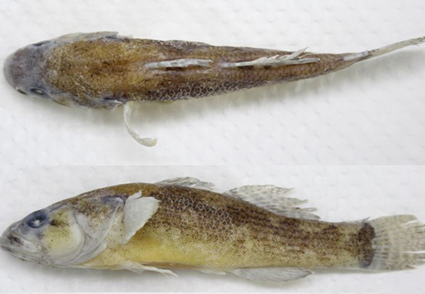Abstract
A new species, Neodontobutis lani (Odontobutidae) is described from the Zuojiang River, a tributary of the Xijiang River of the Pearl River basin, at Longzhou Town, Guangxi Zhuang Autonomous Region, Southern China. This species can be distinguished from other Neodontobutis species by following characters: anterior head flat, with interorbital width / eye diameter = 1.4–1.9 (vs. less than 1.4); several rows (vs. single row) of transforming ctenii on posterior edges of body scales; sensory papilla on lower jaw arranged in two oblong clusters (vs. two single lines). It can be distinguished from Odontobutis species by: separated right and left gill membrane (vs. joined); barbel-like projection present on sensory papillae. Molecular phylogenetic analysis of 2,076 nuclear coding loci indicates that N. lani is a sister species of N. hainanensis, the only Neodontobutis species that has been described from China.
References
Chen, I.S., Kottelat, M. & Wu, H. (2002) A new genus of freshwater sleeper (Teleostei: Odontobutididae) from southern China and mainland Southeast Asia. Journal of the Fisheries Society of Taiwan, 29, 229–235.
Edgar, R.C. (2010) Search and clustering orders of magnitude faster than BLAST. Bioinformatics, 26, 2460–2461. https://doi.org/10.1093/bioinformatics/btq461
Hoese, D. & Gill, A. (1993) Phylogenetic Relationships of Eleotridid Fishes (Perciformes: Gobioidei). Bulletin of Marine Science, 52, 415–440.
Iwata, A. (2011) Systematics of odontobutidae. The Biology of Gobies. Science Publishers, Enfield, 61–77.
Katoh, K. & Standley, D.M. (2013) MAFFT multiple sequence alignment software version 7: improvements in performance and usability. Molecular Biology and Evolution, 30, 772–780. https://doi.org/10.1093/molbev/mst010
Khoa, N. & Duc, N. (2012) New species of genus Neodontobutis (Gobioidei: Odontobutidae) from Khe Khang stream in Pu Mat national park. TAP CHI SINH HOC, 33. https://doi.org/10.15625/0866-7160/v33n1.728
Kottelat, M. (2001a) Fishes of Laos. WHT Publications, Colombo, 198 pp.
Kottelat, M. (2001b) Freshwater Fishes of Northern Vietnam. World Bank, Washington, 11 pp.
Kumar, S., Stecher, G., Li, M., Knyaz, C. & Tamura, K. (2018) MEGA X: Molecular Evolutionary Genetics Analysis across Computing Platforms. Molecular Biology and Evolution, 35, 1547–1549. https://doi.org/10.1093/molbev/msy096
Li, C., Hofreiter, M., Straube, N., Corrigan, S. & Naylor, G.J. (2013) Capturing protein-coding genes across highly divergent species. Biotechniques, 54, 321–326. https://doi.org/10.2144/000114039
Li, H., He, Y., Jiang, J., Liu, Z. & Li, C. (2018) Molecular systematics and phylogenetic analysis of the Asian endemic freshwater sleepers (Gobiiformes: Odontobutidae). Molecular Phylogenetics and Evolution, 121, 1–11. https://doi.org/10.1016/j.ympev.2017.12.026
Meyer, M. & Kircher, M. (2010) Illumina sequencing library preparation for highly multiplexed target capture and sequencing. Cold Spring Harbor Protocols, 2010, pdb. prot5448. https://doi.org/10.1101/pdb.prot5448
Minh, B., Schmidt, H., Chernomor, O., Schrempf, D., Woodhams, M., von Haeseler, A. & Lanfear, R. (2020) IQ-TREE 2: New Models and Efficient Methods for Phylogenetic Inference in the Genomic Era. Molecular biology and evolution, 37. https://doi.org/10.1093/molbev/msaa015
Rambaut, A. (2013) FigTree v 1.4.2. Available from: http://tree.bio.ed.ac.uk/software/figtree/ (accessed 12 Jan 2022)
Simpson, J.T. & Durbin, R. (2012) Efficient de novo assembly of large genomes using compressed data structures. Genet Res, 22, 549–556. https://doi.org/10.1101/gr.126953.111
Slater, G.S.C. & Birney, E. (2005) Automated generation of heuristics for biological sequence comparison. BMC Bioinformatics, 6, 31. https://doi.org/10.1186/1471-2105-6-31
Vidthayanon, C. (1995) Odontobutis aurarmus, a new species of odontobutid goby from wetlands of the Mekong basin, Thailand. Ichthyological Exploration of Freshwaters, 6, 235–242.
Wang, Y., Yuan, H., Huang, J. & Li, C. (2022) Inline index helped in cleaning up data contamination generated during library preparation and the subsequent steps. Molecular Biology Reports, 49, 385–392. https://doi.org/10.1007/s11033-021-06884-y
Wu, H.L., Zhong, J.S., Chen, I.-S., Chong, D.H., Ni, Y., Shen, GY., Zhao, S.L. & Shao, K.T. (2008) Fauna Sinica, Ostichthyes, Perciformes (V), Gobioidei. Beijing: Science Press.
Yuan, H., Atta, C., Tornabene, L. & Li, C. (2019) Assexon: assembling exon using gene capture data. Evolutionary Bioinformatics, 15, 1176934319874792. https://doi.org/10.1177/1176934319874792

